.jpg)
Informative, helpful content has become an integral part of any digital marketer’s arsenal. It makes sense: if people value your content they value your site, your brand, and hopefully the product or service you’re selling.
Unique content is a way to boost traffic to a website. To make that happen, marketers need to pay attention to the quality of the content, promote via social, and “pay attention to SERPS” (Search Engine Results Pages).
But have you ever thought about speed?
People are more likely to read content that loads faster. And now, both Facebook and Google have ways for businesses who publish content to prioritize speed.
To make your content quickly accessible on people’s news feeds, you can now use Facebook’s Instant Articles. Initially, the tool was only available to certain publisher, but that’s no longer the case.
To get your content to rank higher in the SERP, you can use Google’s Accelerated Mobile Pages (AMP).
Anyone can take advantage of AMP because it’s open source. When people are surfing the web, sites with Accelerated Mobile Pages will show up ahead in Google search results. That’s because their AMP content will be cached in the cloud – all relevant content on a page, including images and ads, will appear to the user only when they scroll over it.
For Instant Articles, anyone can now use it, but Facebook places limits on how many ads publishers can put into an article. If you’re doing content marketing, though, this isn’t a concern. Links in the article to relevant pages on your site, including sales pages, are the equivalent of ads. The optimum setup is a content marketing strategy alongside a Facebook advertising strategy.
In terms of converting your audience into customers, the marketplace is shifting to mobile commerce. In 2014, tablets and smartphones had a combined conversion rate of 3.22%, compared with 2.8% for laptops and computers.
This corresponds with smartphone sales. According to research from Pepperdine University, the US smartphone market was already saturated by the end of 2014. Globally, Pepperdine’s sources projected smartphone sales to grow by 18% in 2015.
Interestingly, Gartner reports 2015 smartphone sales fell about 5% short of that 18% mark. Still, despite a slight decline once more in 2016, by the end of the year 82% of mobile phones will be smartphones.
People love to browse their Facebook News Feed while they’re riding the subway to work or while they’re out and about at events. This is a great chance to show them content they may share with their friends.
For Facebook, the mobile content marketing strategy looks something like this:
- Curate and create awesome articles with keyword-optimized internal links to pages on your site, as well as links to external, authoritative sources
- Publish them on your blog
- Turn them into Instant Articles via Facebook for developers
- Promote them – when a user shares your article, the user’s friends will be able to access it instantly
- Watch your site gain authority as more people share articles and more backlinks accrue; hopefully, this will lead to conversions
What’s more, you’ll have the SERPs covered if cache your articles in the cloud via Google AMP. Again, Google is officially saying they will prioritize AMP articles. That means they’ll show up ahead of your competitor’s articles. And that’s good news.
[Source:- Socialmediatoday]








